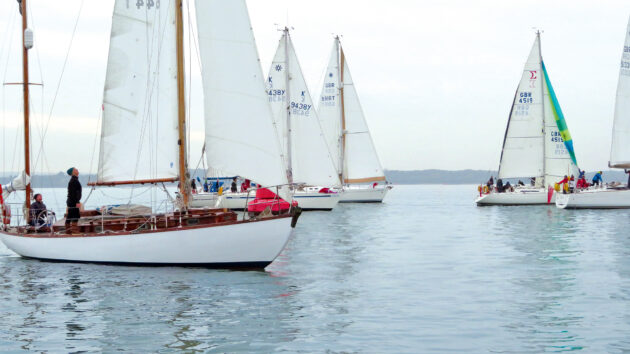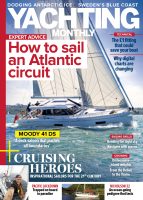Every month through the winter, scores of sailors sign up for the Little Ship Club’s ‘fast cruises.’ Dick Durham joins one and reports back
And then there was light, most welcome it was, too after a gruelling drive via several motorways into the pitch black New Forest. I drove on, motivated by the thought that somewhere ahead of me, a berth aboard a Nicholson 35 awaited and a glass or two with the skipper and crew.
Thankfully the receptionist at the Master Builder’s House Hotel was a local lass and knew where Gin’s Farm was. Down through a winding lane, converted to a fairy-tale tunnel from overhanging and leafless oaks, I at last saw the light of Gin’s Farm reflected in the cold, low tide mud of the Beaulieu River.
Barrie Martin, commodore of the Little Ship Club and his crew Celia Greetham, batted not an eyelid between them at my late arrival for scampi and chips, perhaps because the quiz night organised by their hosts, the Royal Southampton Yacht Club, had not yet started.
At the end of the pontoon lay A Day at the Races, the lovely classic Nicholson 35 built in 1966 – the 14th of 28 boats all originally named Yeoman – for legendary ocean racing yachtsman and former RYA president, the late Sir Owen Arthur Aisher.
Barrie’s head-torch picked out the boat’s guard rail as he helped me aboard. Shortly afterwards, I collapsed under the duvet of a comfortable settee berth to port, while Barrie, 77, a retired investment fund manager, doubled up with Rumpole of Battersea, his Madagascan terrier, and Celia, a physiotherapist, took the fo’c’sle.

The Nicholson 35 prepared to cast off at Gin’s Farm jetty. Photo: Dick Durham
A grey and windless dawn was made far less cheerless by proper coffee expertly brewed by Celia, whose masterful skills on the foredeck were matched only by her elan, down below, as a barista.
I had joined Barrie and Celia for one of the Little Ship Club’s winter programme of ‘fast cruises’. These are exercises in what Barrie describes as ‘intellectual seamanship’ and they make good sense for many: rather than go to the expense and rigmarole of haul-out, lay-up, and winterising, while hankering after next season’s March, they keep sailing right through the year instead.
To ensure sailors can be lured away from their firesides, the fast cruises are designed to make the most of the daylight hours, with all the passage-planning, tidal analysis and wind-reading involved for a long summer voyage, compacted into a cruise-lite sail in company with a not-too-distant run ashore planned with a sympathetic mid-winter venue in the evening.

Crew Celia, a physiotherapist, takes out the Fortress anchor. Photo: Dick Durham
Setting off from Beaulieu
The idea seems to have taken off as there were 17 boats due to meet in the Solent not including, A Day at the Races, which had been freshly antifouled and the top planks of her post-box-red topsides sanded.
We motored out of the Beaulieu River and found about five knots of wind from the north in the Solent. Barrie and Celia bent on the genoa and then they set the mainsail, while I helmed the finger-light wheel of a true thoroughbred.
We motor-sailed eastward to the muster point off the North East Ryde middle red can buoy somewhere to the north of Osborne Bay and hovered around until the fleet gathered.
With a ferry and two dredgers approaching from the east we took bearings of their aspect and when the latter did not alter, put on power to clear her head: a refresher course in collision avoidance, used by Barrie many times during his summer cross-Channel cruises to Brittany.

Barrie Martin at the helm of A Day at the Races on a winter outing of the Little Ship Club with Dick Durham. Photo: Dick Durham
With a nominal ‘start’ time of 1130 we took our own time, as did the others, and rounded the buoy to head towards the north shore and hoped for a weaker ebb tide. The wind had petered out but fickle zephyrs from the north-east allowed us to creep forward among half a dozen angling boats. We moved ahead, stalled, went stern-first, before moving ahead once more. In this manner we drove eastward on the tide past the Browndown conical buoy.
Learning on the job
Today’s ‘intellectual seamanship’ was to learn – fast – about the different set, and strength of the multi-variable tides and currents of Solent and Spithead. You can Google them, you can study the experts, read the books, but nothing will ‘learn you’ more swiftly than conning an 11-ton boat forwards, backwards and sideways among the fixed points of anchored craft, each with an owner and pals scowling at you over their dipped rods and swiftly retrieved, still-baited hooks.
It was like a living Mike Peyton cartoon: the anglers just looked morose with an understated huffiness, the sailors avoided eye-contact and nobody said a word. No wonder Mike’s cartoons rarely required a caption.
When the wind died completely, Celia hauled out a lightweight Fortress anchor from below: with a large label glued on its fluke proclaiming ‘The best anchor in the world.’ Having unshackled the boat’s 32 kilo CQR bower anchor chain she re-attached it to the Fortress, lowered it over the bow, and after some time, the boat came to a halt while we enjoyed lunch in the cockpit.

A Day at the Races sailing to windward. Photo: Dick Durham
Most of the rest of the fleet, we later learned, had anchored, too, over the top of the Ryde Bank which they had tried to negotiate, also hoping to face a weaker ebb.
Just as we finished sandwiches, pork pies, crisps and smoothies, the surface ruffled towards the north-west.
‘Wind,’ said Barrie and the Fortress anchor was hauled back aboard.
‘It’s got circles of chain around it,’ said Celia. ‘Really? The best anchor in the world?’
‘We dropped it too quickly,’ Barrie decided as the boat started making three knots over the ebb.
‘Just as well we’re on neaps,’ he added as we headed back west and back in among the angling boats.
This time their lines remained untouched, thrumming for bass, as we passed them without fuss.
Short-tacking along the edge of the sands off Lee-on-Solent we rounded our next mark – the Hill Head buoy – and A Day at the Races’ voluminous asymmetric spinnaker was hauled aloft, collapsing over the shrouds at first, but then after judicious hoisting and lowering, hauling back and forth of the spinnaker pole by Celia, the great sail blossomed and we scooted nicely towards the West Ryde Middle cardinal before dropping it.
Dusk was approaching and we checked our nav lights and turned on the masthead light as it was time to motor in to Cowes. A neat reminder to all crews about the correct nav lights required.

Photo: Dick Durham
We then motored into Cowes, passing the breakwater to starboard and rafted up three-deep at Shephards Marina before the evening muster at the Royal London Yacht Club headquarters. The Royal London has now merged with the Royal Thames Yacht Club for an official ‘reciprocity’ arrangement, basically the twinning of the Little Ship Club and the Royal London Yacht Club, with a ritual of burgee exchange between Barrie and Shelagh ‘Bunny’ Jones, commodore of the Royal London.
Because of the lack of wind nine boats dropped out of the fast cruise, but all turned up for the supper. Some 200 LSC sailors and their crews then met for dinner at the Sir Max Aitken Museum where we ate beneath the hanging gaff of the original Royal Yacht Britannia which featured in the very first issue of Yachting Monthly in 1906.
The museum features framed Giles’ cartoons, as Aitken was the son of Lord Beaverbrook, the newspaper tycoon who led the Daily Express to selling 5m copies a day. I joined Express Newspapers to work on the Daily Star founded by Beaverbrook’s successor, Lord Matthews, and often met Giles, a sailor, who lived on the East Coast.
The evening was brought to a close with a male choir called the Dockyard Dogs regaling diners with sea-shanties.

he Little Ship Club fleet in the Solent. Photo: Dick Durham
Little Ship Club history
Novice boat owner Robert Gibbon, who described himself as ‘keen but ignorant’ wrote to YM sister journal, Yacht Sales & Charters in October 1926 suggesting a forum where yachtsmen could gather in the winter months, to ‘swap expertise and yarns’ and so the Little Ship Club was formed.
The LSC’s first ‘HQ’ was the Ship Restaurant in Whitehall, where 27 enthusiasts met.
The founder members were all men but women were welcomed in 1927 as full members, one of the first clubs in the UK to become gender-tolerant!

The route taken on the Little Ship Club’s fast cruise
In 1928 the club moved its meetings to the Old Ship Tavern in London and gave classes in seamanship and navigation plus holding a fortnightly lecture. By 1932 membership had risen to over 500 and it was decided that the club should have a permanent office and a paid office staff. Arrangements were made with the Hudson Bay Company and the club became tenants at Beaver Hall.
This arrangement lasted for 30 years during which time membership increased to 4,000.
The training classes became so successful that in 1936 the Admiralty used the club to train members of the Royal Naval Supplementary Volunteer Reserve. In recognition of this the Admiralty granted permission to fly a defaced Blue Ensign.
In 1960 the club took out a lease on an old coal wharf downriver from Southwark Bridge on the north bank of the Thames.
Between 1986 and 1991 while the club site was being re-developed, members used a temporary home with the Naval Club in Mayfair. Little Ship Club members now enjoy reciprocal membership.
In 2001 the club celebrated 75 years with a dinner in the Painted Hall at the Royal Naval College Greenwich. The club’s 90th year was celebrated with a black-tie dinner at Trinity House. YM’s Dick Durham and wife, Cathy, were guests.
Enjoyed reading this?
A subscription to Yachting Monthly magazine costs around 40% less than the cover price, so you can save money compared to buying single issues.
Print and digital editions are available through Magazines Direct – where you can also find the latest deals.
YM is packed with information to help you get the most from your time on the water.
-
-
- Take your seamanship to the next level with tips, advice and skills from our experts
- Impartial in-depth reviews of the latest yachts and equipment
- Cruising guides to help you reach those dream destinations
-
Follow us on Facebook, Twitter and Instagram.





